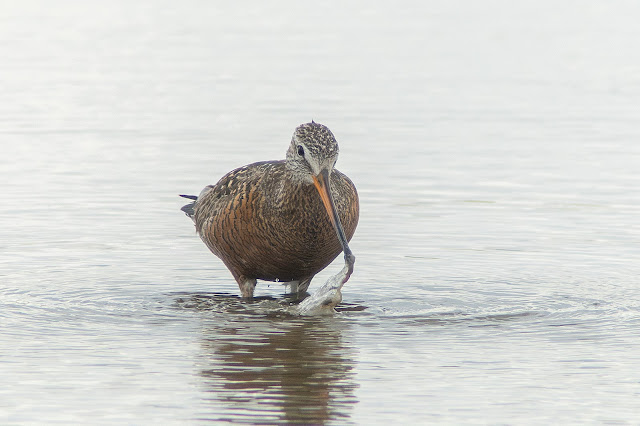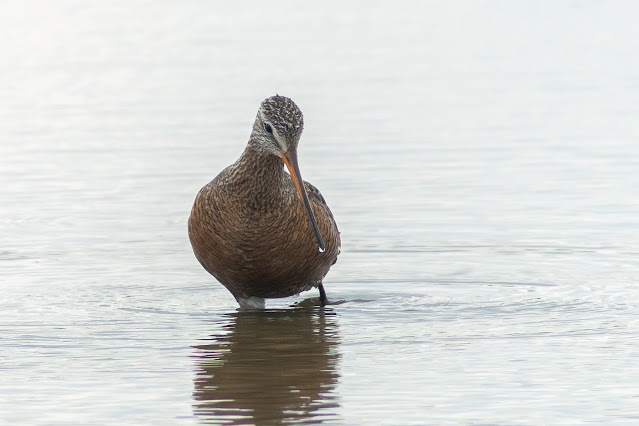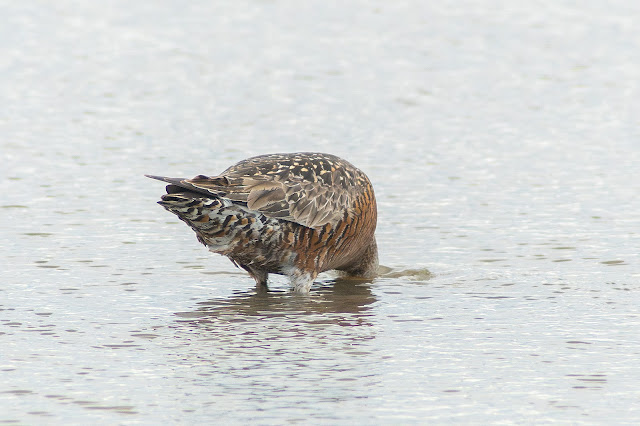Hudsonian Godwit @ Erie Marsh - 13 Jun 2023
Early this afternoon Bruce Arnold posted a photo of an absolutely gorgeous Hudsonian Godwit (Limosa haemastica) in breeding plumage at Erie Marsh Preserve in s. Monroe Co. I was out the door and headed to the Gun Club in minutes. Skies were cloudy with thundershowers forecasted after 6 pm so I was hoping they'd hold off while I drove south on I-75 at 2:30 pm. Scattered rain showers dotted the windshield along the way, and winds were picking up by the time I arrived shortly after 3 pm.
I saw Bruce as I started walking out onto the dike, which was freshly graded that day, and he directed me to Pool 4 where the bird was foraging. The dike was easy to walk this afternoon* and I beat it out there as fast as I could carrying the scope, tripod, and Sony a1/600mm combo. Geoff Malosh was already there photographing the bird as I approached.
The Hudsonian Godwit was easy to spot as it was the only bird (other than a handful of Semipalmated Sandpipers) in the area and was foraging in the pool in belly-deep water. It flew toward and past me as I approached Geoff and I managed to get some pics as it landed in the pool behind me. The flight shots gave me the opportunity to see the gorgeous white stripe and black scapulars on the wings, black tail with white rump, and even black back feathers not normally seen in the field.
I spent the next 40 minutes or so photographing the bird w/ the Sony a1 + 600/4 combo (see blog post at birdingthroughglass.blogspot.com) and with the digiscoping rig of Swarovski STX85, 25-60X eyepiece at 25X, Sony a1 + Sony 40mm f/2.5 at f/2.5, and Digidapter™ DLM. Images were taken at EFL ~1000 mm and 1500 mm (1.5X crop) using Auto-ISO w/ minimum shutter speed of 1/1000 sec. Focus-peaking was extremely important to get razor-sharp images of the godwit that was backlit by the late afternoon Sun. The bulk of its diet while I was present appeared to be Tubifex worms (Tubifex sp.). They didn't stand a chance...
While driving home I was curious if it might possibly be a Black-tailed Godwit (L. limosa) since I saw the black tail in flight. I had to look up the two species to verify that it was indeed a Hudsonian Godwit based on the gray neck and head (compared to the orange head and neck of a BTGO). Interestingly, Birds of the World cautions using this trait as it is unreliable in the field due to variations in molt and lighting.
 |
| Black-tailed Godwit (L. limosa) © Birds of the World |
We normally only see Hudsonian Godwits during early spring and late fall migration windows while they are in basic (gray) plumage, so this was a rare and real treat. A look at their distribution shows why they are so unusual to find.
According to the Birds of the World (birdsoftheworld.org) Hudsonian Godwits were once considered one of the rarest birds on the continent:
The Hudsonian Godwit, known in the past as the Ring-tailed Marlin or Goose-bird, is the least well known of the world's 4 godwit species. With the majority of its population restricted to only a few remote sites during much of the year, it was long regarded as one of the rarest birds on the continent, ranked with the likes of Kirtland's (Dendroica kirtlandii) and Bachman's (Vermivora bachmanii) warblers by the American Ornithologists' Union's Committee on Bird Protection (Allen et al. 1944). Starting in the 1940s, however, biologists began to discover large migratory flocks at remote sites along the shores of James and Hudson bays, leading to the realization that the status of the species was not as dire as it had seemed. More recently, additional fall staging sites have been found in Saskatchewan, along with major wintering areas in southern South America. The species is, nonetheless, highly vulnerable, with a population of between 50,000-70,000 birds, the majority of which occur at only a handful of sites during the nonbreeding season.
Some notes about their spring migration:
First arrives in North America in early April, with first individuals often found well inland of the mid-Texas coast (Senner unpubl.). Moves north, primarily west of the Mississippi River, between 90 and 100°W in the U.S., and across a wider range once it reaches s. Canada. Largest concentrations at Cheyenne Bottoms, KS; Lake Thompson, SD; Kingsbury Co., SD; e. Rainwater Basin, NE; and Jackson Co., TX (Skagen et al. 1998b) (Jorgensen 2008). Appears to be a bimodal migration, with an early peak in central North America occurring in mid-April and a second, larger peak during May, that likely has to do with the earlier arrival of s.-central Alaska breeders (NS).
Representative dates of occurrence during spring migration: n.-central Texas, late Mar–late May (Pulich 1988b); Kansas, early Apr–late May (Thompson and Ely 1989), with 50% of birds at Cheyenne Bottoms seen during last 2 wk of Apr (Helmers 1991); w. Minnesota, late Apr–early Jun (Janssen 1987); e. South Dakota, late Apr–late May (South Dakota Ornithologists' Union 1991).
Uncommon spring migrant in southern part of Prairie Provinces. Regular in small numbers during late Apr and early May in e. Alberta. In Manitoba, regular along Hudson Bay coast, irregular to the south (Salt and Salt 1976). In s. Yukon, small numbers in May, primarily in Southern Lakes area near Whitehorse; most records between 8 and 13 May and involve 1 or 2 birds, but larger numbers (maximum flock size of 52) reported occasionally (Eckert 1999a, Sinclair 2003). Elsewhere in North America, occurs only as a rare spring migrant.
First reaches s. Alaska breeding grounds during last week of Apr, nearly all birds on breeding territories at Susitna Flats by first few days of May (Isleib and Kessel 1973, Kessel and Gibson 1978). Historical records over a 37 yr period put this average at May 2. Arrival is delayed somewhat in years of heavy snow or shorefast ice (T. Tobish unpubl.); earliest arrivals in w. Alaska during first week of May on Yukon-Kuskokwim Delta and in Kanuti NWR (McCaffery and Harwood 2000); by mid-May on Seward Peninsula (Kessel 1989).
Historical first records show an average arrival date in Churchill, Manitoba of May 22 over a period of 24 yr (NS), with spring migration peaking in late May and very early June (Jehl and Smith 1970, Cooke et al. 1975b).





























Comments